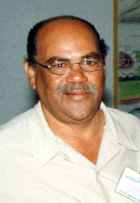Says objection to Forestry Commission role in granting mining approvals `non negotiable’
Impending new state regulations requiring miners to provide the Guyana Geology and Mines Commission (GGMC) with a six-month notice of the areas they intend to mine and for which approval would be subject to recommendations made by the Guyana Forestry Commission (GFC) could create chaos in the country’s mining industry according to Executive Director of the Guyana Gold and Diamond Miners Association (GGDMA) Edward Shields.

In an exclusive interview with Stabroek Business earlier this week Shields made no secret of what he said was the “strong objection” of members of the Association to new regulations. He said that miners strongly opposed what appeared to be the granting of considerable “veto powers” to the GFC in the mining sector. “Our mandate from members at a January 8th meeting of the Association which was attended by more than 200 miners has been a total rejection of the recommendations,” Shields told Stabroek Business, adding that the advent of the new regulations had created “an impasse” between the miners and the authorities since the position of the Association on the regulation rendering approval to mine contingent on the GFC’s recommendation was that it was “a non-negotiable item.”
Shields said that up until earlier this week the Association was treating the new regulations as a proposal rather than “a done deal.” However, he made no secret of the fact that miners have struck a robust posture which appears to send signals that they were bracing themselves to resist the implementation of the new regulations. Asked about the likelihood that government may proceed with the new regulations despite the President’s move to establish a consultative forum Shields responded: “I would not be surprised.” He said that anomalies in the administration of the mining sector including the issuance of cease work orders by Mines Officers in circumstances where they had no authority to issue such orders had been known to occur in the sector.

Last week Head of the Presidential Secretariat Dr. Roger Luncheon was quoted in sections of the media as saying that the response by the miners to the new regulations reflected an unwillingness to face the reality of the environmental impact of irresponsible mining, a view which Shields said he totally rejected. He said that while the miners were aware of the importance of regulations designed to protect the environment the new measures appear designed to create “an exit strategy” from the sector for small scale miners.
Dinner
Beyond the miners’ concerns over what they believe will be the negative impact of the new regulations on the sector Shields said that while members of the GGDMA are responsible for the vast majority of the country’s gold yield, the Association had not been consulted during the discourses that led to the announcement of the new regulations nor was it formally invited to the forum at which the announcement was made. He said that the first public disclosure of the proposed new regulations came at a dinner hosted by President Bharrat Jagdeo for the country’s twenty top miners in December. “As far as I learnt, apparently the President outlined the scenario for mining in 2010. Basically he said that the miners would have to do some prospecting before mining and that miners would have to undertake reclamation. I understand that there was also a presentation by James Singh (Head of the Guyana Forestry Commission). I suspect that the new regulations are based on the recommendations of the GFC.”
Shields told Stabroek Business that the disclosures made at the Dinner had prompted an

immediate response from the miners arising out of which the President had decided to establish a committee on land use. The Committee is chaired by Works and Transport Minister Robeson Benn and includes Singh, GGMC Acting Commis-sioner William Woolford and Presidential adviser on Empowerment Odinga Lumumba. “Afterwards,” Shields told Stabroek Business, “the President informed the Association that it could have four representatives on the Committee.” The GGDMA named representatives on the land use committee include Shields and President of the Association, Major General (ret’d) Norman McLean. However, according to Shields, while the Committee had held two meetings earlier this month – neither of which he had attended since he was overseas – the GGDMA is still unclear about its terms of reference. A third meeting was due to be held last Monday and Shields said that he expected that the terms of reference would be disclosed at that meeting. Shields confirmed that he would attend the meeting but said that he remained concerned that up to this time there had been no opportunity for the Association “to be heard on the matter of these new regulations.” He noted that this lack of consultation appeared to take no account of the fact the members of the GGDMA were responsible for around 80 per cent of al gold mined in Guyana, a circumstance which he said indicates that the Association “has relevance in the sector.”
“Frankly, I do not see how we can go forward unless the situation is cleared up to the satisfaction of the miners. Here, I am referring specifically to the requirement that the small scale miner gives six months notice before he can mine and the perception that the GFC will have veto power, that is, that they will have to provide a no objection before the small scale miner can proceed with mining. That would have to be clarified before we can go forward since the authority for mining rests with another agency, namely the GGMC. We want to deal with the GGMC and the GGMC alone. We do not want, at any time to be subject to a decision by another agency regarding whether or not we can mine,” Shields said.
Concerns have arisen within the mining community over what Shields says is the

coincidence between the promulgation of the Low Carbon Development Strategy (LCDS) which is being driven personally by President Bharrat Jagdeo and the seeming determination by the authorities to‘get tough’ with the implementation of mining regulations designed to arrest environmental degradation. Shields told Stabroek Business, however, that at a meeting with miners last year the President had sought to provide assurances that the LCDS was not intended to injure the mining industry. He said, however, that while there had always been an awareness of the need to adhere to those regulations designed to protect the environment, the oversight prerogative which the GFC now appears to have been granted suggested that “a new regulation is now being thrown into the pot.”
Jousting
The involvement of the GFC in arriving at a determination regarding permission to carry on mining activity has arisen out of what appears to be persistent jousting between the mining and forestry sectors over the apportioning of blame for the indiscriminate felling of trees. Forestry sources have told this newspaper that while that sector remains under the strictest possible scrutiny through regulations that provide strict directives on the felling of trees, sections of the mining industry had been guilty of indiscriminate land-clearing including the felling of trees in areas believed to be gold-bearing ones. However, according to Shields, “there is a notion being pedalled out there that miners are felling as many trees as loggers in their pursuit of gold. This is an issue that needs to be dealt with. The forestry sector is claiming that in 2007 miners were guilty of deforestation in the extent of 24,000 hectares. Interestingly, the GGMC’s records show that last year (it was) 4000 hectares. This amounts to a six-fold difference between one year and the next in terms of the records of the two agencies. Despite the difference in the years the disparity in the figure is sufficiently wide for us to seek to determine which of the two figures is really accurate,” Shields said. Shields said that it was these kinds of statistics that appeared to have pushed the authorities in the direction of creating the new regulations.
And according to Shields the implementation of the new regulations had given rise to concerns that go beyond the mining sector. He said that concerns over the likely impact of the regulations on small scale mining had been raised by various other sectors that service the mining industry including operators in the aviation, road and river transport and food and mining supplies sectors. “It should also be noted that there are private businessmen who have billions of dollars invested in the mining sector both directly and indirectly. Many of the miners are financed by these private businessmen. They are all very concerned about the likely fate of the industry,” Shields said. He added that account also needed to be taken of the contribution of the mining sector to the ongoing development of the interior particularly through the upgrading of existing roads and the construction of new and important road links between and among interior communities financed by royalties paid to the state by the mining sector.
Legal challenge
Meanwhile, the GGDMA Executive Director hinted that the new regulations may be vulnerable to legal challenge, pointing out that the framers of the new regulations appeared to overlook the fact that these had not been grounded in any prior legislation. ‘What we should be dealing with at this stage is proposed legislation to be tabled in Parliament in the form of a bill, not proposed regulations. It is only after that legislation has been assented to that we can move forward with regulations,” he said, adding that what most concerned him about the new regulations was whether any prior legal advice had been sought from the Attorney General’s office.
The GGDMA Executive Director told Stabroek Business that he considered it unnecessary to add to the already existing voluminous regulations governing the mining industry. “The deficiency lies in the effectiveness with which the existing regulations are being enforced. For various reasons including scarcity of staff at the GGMC the existing regulations are not being enforced. I understand, for example, that the President himself has noted that there have been instances in which GFC Rangers have been dismissed or charged for various reasons. That kind of record does not exist in the case of the GGMC officers.”
Shields said that there were instances in which he had received complaints from miners that the GGMC’s Mining Officers had issued them with cease work orders for the pollution of rivers. “In many of those cases the miners point out that others who are guilty of the same offence had not been issued with similar cease work orders. These complaints are evidently designed to make a point about the likely reasons why others who have committed the identical offence were not sanctioned,” Shields said.
The new regulations, Shields told Stabroek Business are likely to impact almost exclusively on small scale miners who represent the vast majority of the local mining community. “There is no way that these regulations will affect large scale miners. They already operate within a strict set of rules that require them to undertake prior prospecting and to submit reports. When you apply for your mining licence the GGMC will review those reports after which they will decide whether or not they will issue such licenses. There is also a role here for the Environmental Protection Agency (EPA) which must carry out an Environmental Impact Assessment Study. Medium scale miners are also subject to other, less stringent regulations which require them to sign an environmental impact agreement. Small scale miners are required to post a reclamation bond which has implications for the environment and to which we have no objection.”
And according to Shields the Association was pondering the timing of the new regulations which, he noted, were being implemented at a time when the industry was prospering. Last year the sector declared a total of 305, 172 ounces of gold which at current market prices is valued at more than US$300m. Revenues in royalties and taxes from the mining sector for 2009 are estimated at around US$27m. Shields noted that the GGMC had been buoyed by the performance of the industry and that GGMC Commissioner Woolford had declared that Guyana could be producing one million ounces of gold in five years’ time. “The question that arises is why, at this juncture, these uncertainties are being introduced into the sector.”





